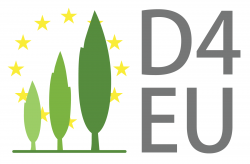The International poplar commission (IPC) has published a new issue of its poplar and willow news recently. The issue also provides some information about D4EU on page 10/11. But of course there are many more worthwhile reports about past events (e.g. the gathering of the Poplar and Willow Council of Canada in June 2017, meeting of the National Commissions of Argentina and Chile, Fifth International Congress of Silicaceae) or ongoing scientific work such as the successful field trial of endophyte-assisted poplar tree phytoremediation of trichloroethylene (TCE). “By partnering the poplar with a native endophyte, a beneficial microbe living within plants, the technologies of phytoremediation and bioremediation were synergistically improved. Poplars have extensive root systems, stabilizing the soils while accessing the polluted groundwater” (Doty, p. 3). Dhiman and Gandhi tell about new hybrids between Populus ciliata and P. deltoides for warm locations like India, which is “a significant step towards indigenization of poplar culture with genes of native species” (p. 5). On page 7 to 9, Teresa Cerrillo provides lots of information about the greater availability of improved willow clones in Argentina. This aims “a reconversion of plantations in search of a critical mass of quality for the industry and the potential for environmental applications” (p. 7). Last but not least the issue shows the new reference work on black poplar, written by D. Ballian, and sums up the latest processes within IPC.
Interested? Here you can get the full text: http://www.fao.org/forestry/ipc/74028/en/
